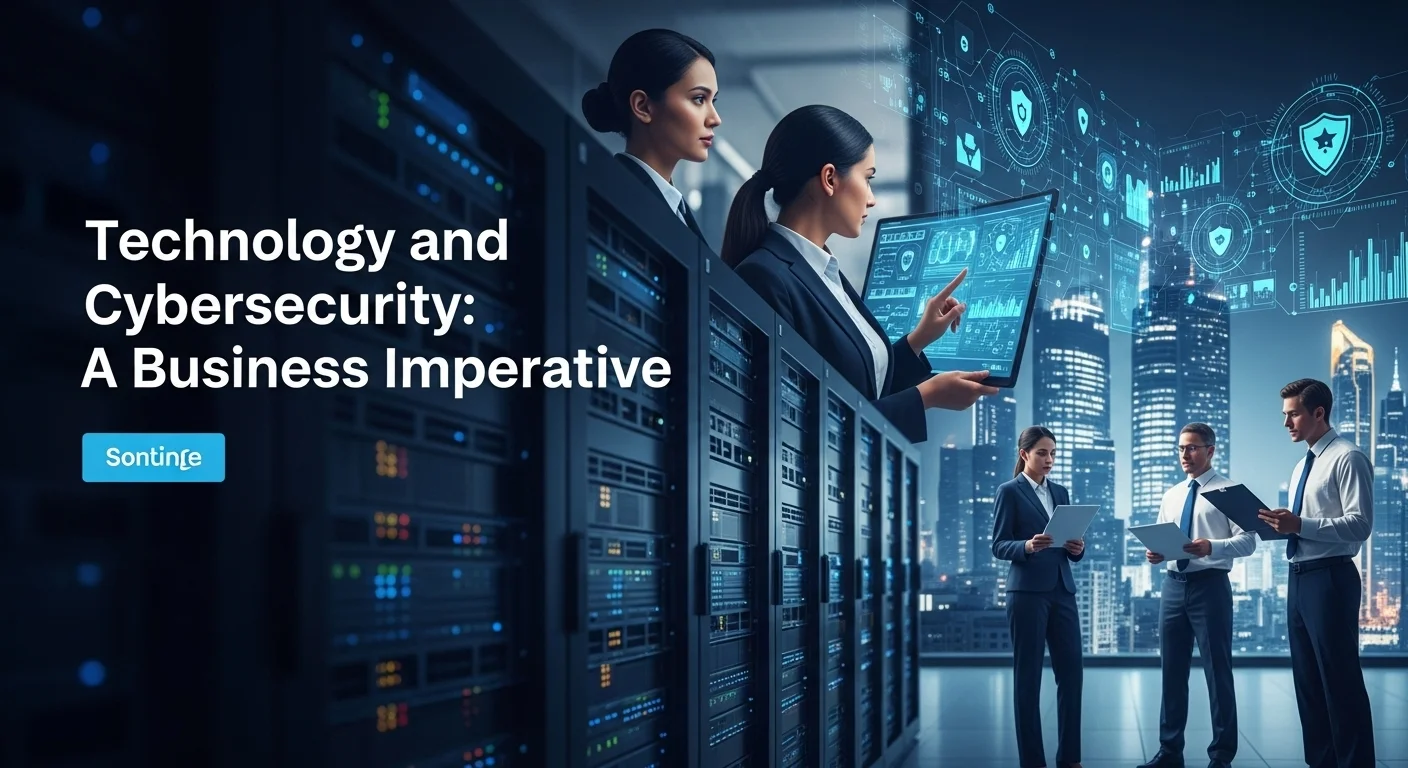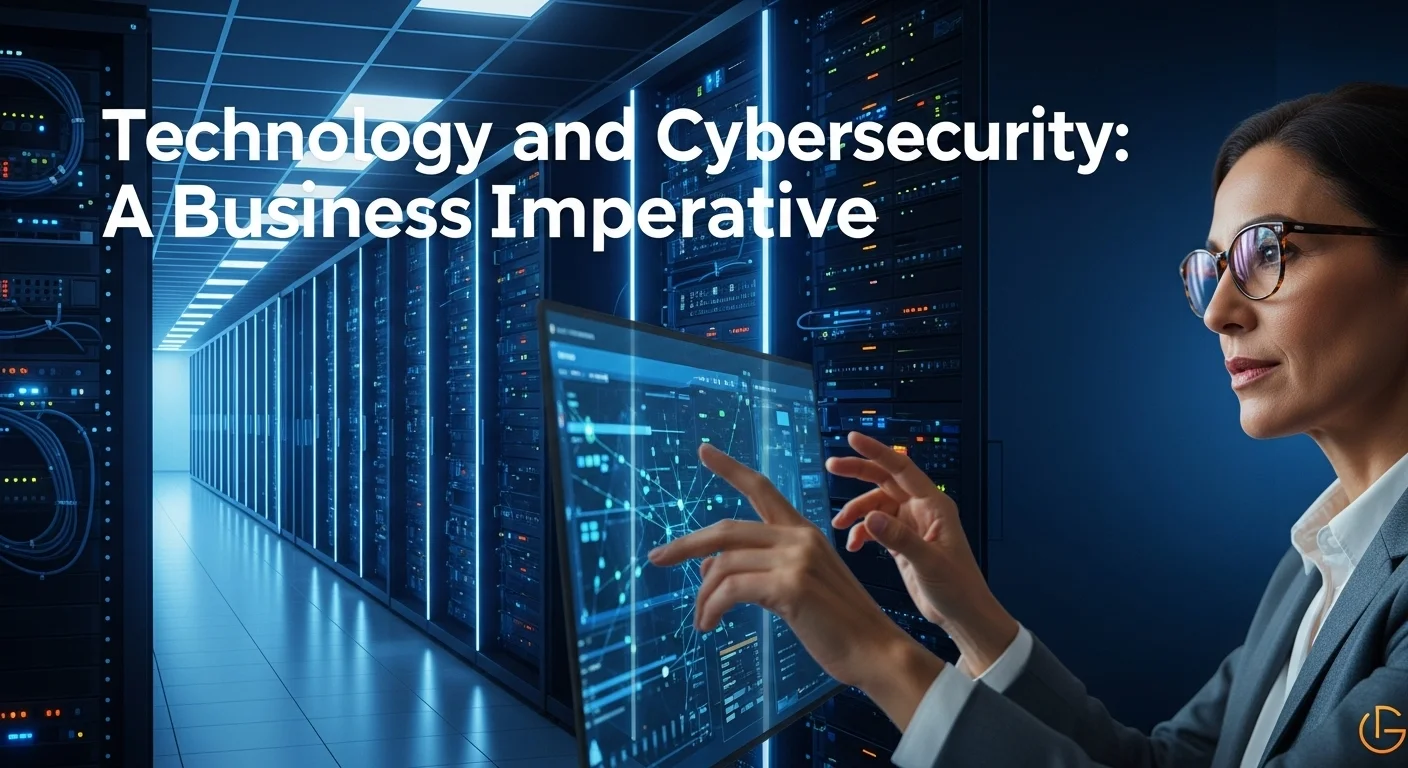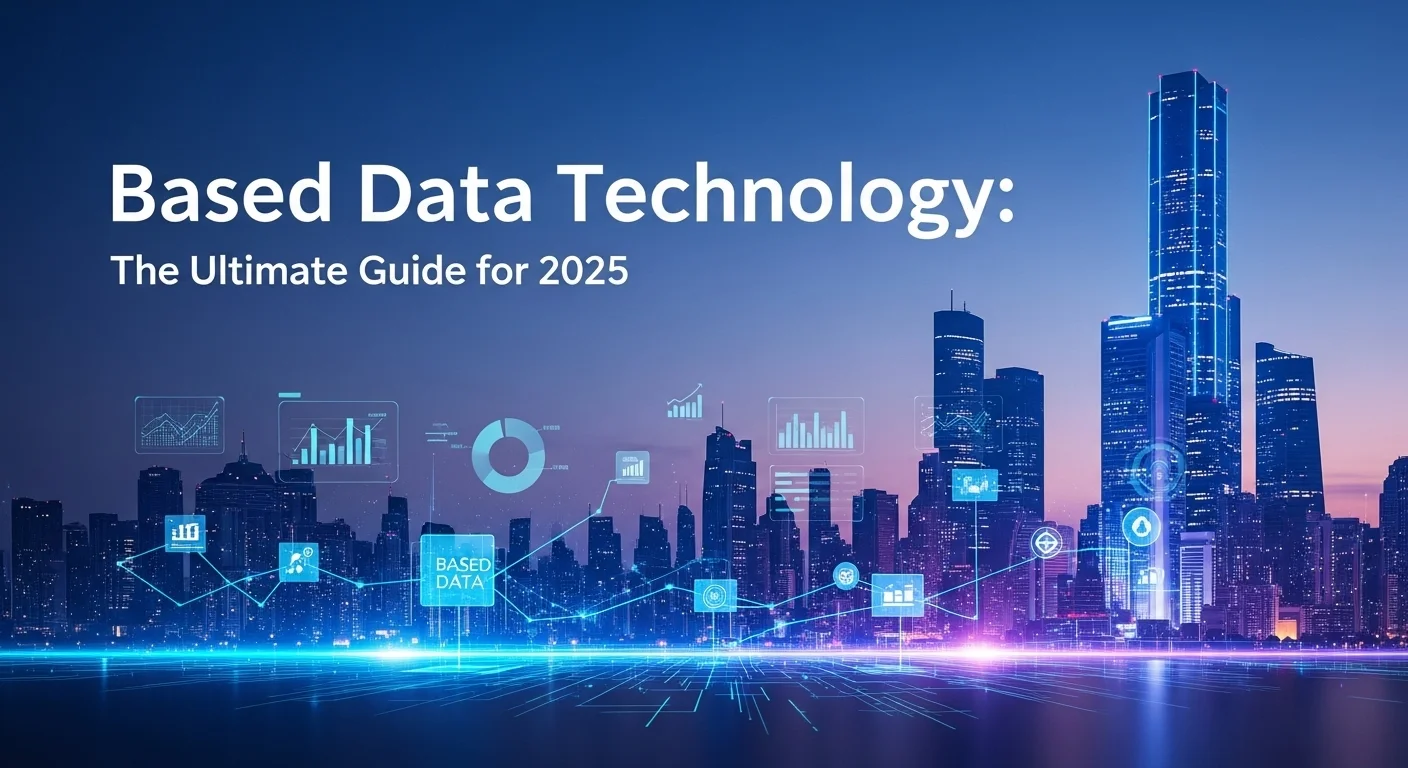Navigating the Digital Minefield: A Practical Cybersecurity Guide for Businesses

Executive Summary
In our connected world, thinking about technology without cybersecurity is like building a house without locks on the doors. It's just not an option anymore. I've spent years helping businesses, especially smaller ones that feel overwhelmed, understand this. They often think they're too small to be a target, but that's exactly what makes them vulnerable. This guide is my attempt to cut through the jargon and give you a real-world look at protecting your business. We'll walk through the essential steps, like figuring out where your biggest risks are with a 'risk assessment,' getting a full check-up with a 'security assessment,' and even simulating a friendly break-in with 'penetration testing' to find your weak spots before the bad guys do. My goal is to help you move from feeling anxious about threats to feeling confident in your defenses, protecting your hard-earned money, customer trust, and peace of mind.
Table of Contents
Table of Contents
- What is Cybersecurity and Why Does It Matter?
- The Evolution of Cyber Threats and Technology's Role
- Cybersecurity for Small Businesses: Why You're a Target
What is Cybersecurity and Why Does It Matter?
I remember one of the first times I talked to a small business owner about cybersecurity. Her eyes started to glaze over. It felt like this big, scary, technical thing that was only for huge corporations. But I asked her, 'Do you lock the door to your shop at night?' Of course, she said. That's cybersecurity in a nutshell: it's the digital lock on your business's door. It’s the practice of protecting your computers, networks, and all the precious data on them from digital burglars. These days, these attacks are all about stealing sensitive info, demanding money, or just bringing your business to a screeching halt. With everything we do online—from sending emails to processing payments—our reliance on technology has made cybersecurity one of the most critical parts of running a business, no matter the size.
In my field, we often talk about the 'CIA triad,' which sounds like something from a spy movie but is actually a simple, powerful concept. It stands for Confidentiality, Integrity, and Availability. Think of it like this: Confidentiality means your secrets stay secret, and only the right people can see them. Integrity means your data is accurate and hasn't been secretly messed with. Availability means you can get to your information and systems whenever you need them. If any one of these is broken, the results can be devastating. A confidentiality breach could leak all your customer details, wrecking your reputation. An integrity failure could mean your financial records are suddenly wrong. And an availability problem, like a ransomware attack, could shut down your entire operation for days.
The Evolution of Cyber Threats and Technology's Role
The game has changed a lot over the years. What started as nerdy pranks has evolved into a multi-billion dollar criminal industry. The threats are no longer simple viruses; they're sophisticated, stealthy attacks that can hide in a network for months. This cat-and-mouse game has been supercharged by the very technology we use. The cloud, our smartphones, and even smart office thermostats create new doors for attackers to try and open. But here's the good news: technology is also our best defense. We now have incredible tools, like Artificial Intelligence (AI), that act like tireless security guards. They can spot the faintest signs of trouble and raise the alarm before a human ever could, learning from every new trick the attackers try.
So, where do you start? You start by understanding what you need to protect. This is where a cybersecurity risk assessment comes in, and it's not as intimidating as it sounds. It’s simply a process of taking stock. You ask: What are our most important digital assets? What are the biggest threats to them? And what would happen if the worst occurred? Answering these questions gives you a clear map of your digital landscape. Without this map, you're just guessing where to build your defenses, maybe putting a huge wall around a garden shed while leaving the front door wide open. And this isn't a one-and-done deal; it's a living process. As your business grows and threats change, you have to keep updating your map with a regular cybersecurity assessment to make sure your defenses are still strong.
Cybersecurity for Small Businesses: Why You're a Target
I have a real passion for helping small businesses with this because they are the most targeted and the most vulnerable. There's a dangerous myth that hackers only go after the big fish. The truth is, cybercriminals are lazy; they'd rather break into ten 'unlocked' small businesses than spend months trying to crack one corporate fortress. An attack that a large company can absorb can be an extinction-level event for a small business. That's why good cybersecurity for small businesses isn't a luxury; it's a survival strategy.
The challenges are real: smaller budgets, no dedicated IT security expert on staff, and a team that's juggling a dozen other jobs. But many of the most effective security habits don't cost a dime. Things like using strong, unique passwords, turning on multi-factor authentication (that little code you get on your phone), and keeping your software updated are incredibly powerful. To take it a step further, I always recommend a proactive approach like cybersecurity penetration testing. It sounds intense, but it can be scaled to any budget. You're essentially hiring an 'ethical hacker' to test your defenses and show you exactly how a real attacker could get in. I've seen the 'aha!' moment on a business owner's face when a pen test reveals a simple, fixable vulnerability they never knew they had. It's one of the best ways to turn weaknesses into strengths before it's too late."

The Complete Guide to Business Cybersecurity Solutions
A solid defense strategy is about more than just having an antivirus program. It's a way of thinking, backed by a deep understanding of the threats and a layered approach to security. I like to think of it as securing a castle: you need strong walls, vigilant guards, and a clear plan of action. This guide will walk you through the technical methods and business strategies to build that kind of resilience.
Know Your Enemy: Understanding the Modern Threat Landscape
You can't win a fight if you don't know who you're up against. Here are the common villains in today's digital world:
- Malware: This is the umbrella term for all nasty software—viruses, worms, spyware. Their mission can be anything from quietly stealing your data to just causing chaos.
- Ransomware: This is one of the most feared. It's digital kidnapping. The software locks up all your files, and the attackers demand a ransom to give you the key. It's a brutal and unfortunately profitable crime.
- Phishing: This is a con game. Attackers send emails or messages that look legitimate—from your bank, a supplier, or even your boss—to trick you or your employees into giving away passwords or financial info. It preys on trust and is shockingly effective.
- Denial-of-Service (DoS) Attacks: The goal here is simple: knock your website or network offline by flooding it with so much traffic that it collapses under the strain. It's like a hundred thousand people trying to cram through a single doorway at once.
- Insider Threats: Sometimes the call is coming from inside the house. This threat comes from current or former employees, whether they mean to cause harm or just make an honest mistake. With their access and knowledge, they can cause significant damage.
Your Proactive Playbook: Assessment and Testing
The Foundation: The Cybersecurity Risk Assessment
As we touched on, the cybersecurity risk assessment is your starting point. It’s your strategic map. I've guided countless companies through this, and it always breaks down into these commonsense phases:
- Define Your Scope: What are we looking at? The whole company? A single department? A new app you're about to launch? You need to draw the boundaries first.
- Identify Your Jewels: You can't protect what you don't know you have. List everything that's critical: customer data, financial records, proprietary software, servers. Then, rank them by how crucial they are to your business.
- Spot the Threats and Weaknesses: For each 'jewel,' what are the threats (like ransomware) and what are the weak spots (like old software or weak passwords) that an attacker could use?
- Analyze the Impact: If a threat becomes real, what's the damage? And how likely is it to happen? This helps you separate the 'might be a problem' risks from the 'this could sink us' risks.
- Prioritize Your Actions: Now you can create a clear priority list. You tackle the high-risk, high-impact problems first, ensuring your limited time and money go where they'll do the most good.
- Document Everything: This becomes your living security playbook, a document you can continuously update as things change.
Going through this process turns security from a vague worry into a clear, manageable business task.
The Full Physical: The Cybersecurity Assessment
If the risk assessment is about identifying potential problems, the cybersecurity assessment is the full health check-up. It's a comprehensive review of your current defenses. It asks: 'How well are our security measures actually working?' This often involves:
- Policy Review: Are our written security rules clear, current, and actually being followed?
- Technical Testing: Are our firewalls, access controls, and other security tools set up correctly and doing their job?
- Compliance Check: Are we meeting the legal or industry standards for our field (like HIPAA for healthcare or PCI for payments)?
- Gap Analysis: Where are the gaps between where our security is now and where it needs to be?
It's the difference between knowing you're at risk for a heart attack and getting an EKG to see how your heart is actually functioning today.
The Fire Drill: Cybersecurity Penetration Testing
This is my favorite part because it makes the risks real. A cybersecurity penetration test (or 'pen test') is where you hire a team of ethical hackers to try and break into your systems. It's a controlled fire drill to see how your team and your tech hold up under a real attack. There are a few ways we do this:
- Black-Box: The testers know nothing about your systems. They approach you just like a real-world external attacker would.
- White-Box: The testers have all the blueprints—source code, diagrams, and administrator-level knowledge. This simulates a worst-case scenario, like a rogue employee with deep knowledge.
- Gray-Box: A middle ground. The testers might have a standard user login, for example, to see how much damage an attacker could do if they compromised a single employee's account.
A good pen test doesn't just give you a list of problems. It tells you a story: 'An attacker could use this vulnerability, then pivot to this system, and finally steal this data.' It's a powerful narrative that shows you exactly what needs fixing, a crucial reality check for any business, especially for a small business where one breach can be the end of the story."

Practical Tips and Strategies to Level-Up Your Cybersecurity
Building a secure business isn't about buying a single magic-bullet piece of software. It's about building smart habits and a security-first mindset. For me, the goal has always been to make technology safer and more reliable so you can focus on what you do best. Here are some of the most effective tips and strategies I've shared over the years, all aimed at turning the insights from your assessments into real-world defenses.
It Starts with People: Fostering a Culture of Security
I've seen companies with the best firewalls get breached because an employee clicked on a simple phishing link. Your team is both your greatest asset and your biggest vulnerability. Making them your first line of defense is the smartest security investment you can make.
- Ongoing Training, Not a One-Off Lecture: Security awareness can't be a single, boring presentation during onboarding. It has to be a continuous conversation. Regular, short training sessions on spotting phishing scams, using strong passwords, and browsing safely are key. I'm a big fan of running fake phishing campaigns—it's a safe way for people to learn from a mistake without any real consequences.
- Lead from the Top: Security culture flows downhill. When the leadership team takes security seriously—using multi-factor authentication and talking about it in company meetings—everyone else follows suit. It shows that security is everyone's job, not just the IT department's problem.
- Write it Down: Create simple, clear security policies. Not a 100-page legal document, but a straightforward guide on how to handle company data, use devices, and what to do if you suspect a problem. Make it easy to find and easy to understand.
Your Actionable Security Checklist
Beyond culture, there are foundational technical controls that provide a massive amount of protection for their effort.
- Lock Down Access: Follow the 'principle of least privilege.' This simply means people should only have access to the files and systems they absolutely need to do their jobs, and nothing more. This dramatically limits the damage if an account is ever compromised.
- Embrace Multi-Factor Authentication (MFA): If you do only one thing from this list, make it this one. MFA is a game-changer. Why? Because even if a hacker steals an employee's password, they can't get in without the second factor, like a code from their phone. Turn it on for everything, especially email and financial systems.
- Patch, Patch, Patch: Hackers love to exploit old, known bugs in software. Set up a regular process to update everything—your operating systems, your apps, your web browser. Most of this can be automated so you can set it and forget it.
- Secure Your Network: Use a firewall to act as a gatekeeper for your network traffic. A great practice is to create separate networks. For instance, your guest Wi-Fi should be completely isolated from your internal company network. And for anyone working remotely, require them to use a VPN to create a secure, encrypted tunnel back to the office.
- Encrypt and Back Up Your Data: Encrypt sensitive data wherever it lives—on laptops, on servers, and especially when it's moving across the internet. Just as important, have a solid backup plan. The 3-2-1 rule is a great starting point: 3 copies of your data, on 2 different types of media, with 1 copy stored off-site or in the cloud. And please, test your backups regularly to make sure you can actually restore them!
Bringing It All Together: Strategic Security
The real power comes when you use your assessments to drive a continuous cycle of improvement. A cybersecurity risk assessment isn't a report you file away; it's a living roadmap.
- Create an Action Plan: After any cybersecurity assessment or penetration test, the results must become an action plan. Prioritize the fixes based on risk, assign them to someone, and set deadlines.
- Justify Your Budget: The findings from your risk assessment are the proof you need to make a case for security investments. It allows you to go to leadership with data, not just fear, to ask for the resources you need.
- Monitor Constantly: The world is always changing, and so are the threats. Use tools that monitor your network for suspicious activity 24/7. And plan to revisit your risk assessment at least once a year to account for new technologies, new business processes, and new threats. This agile approach is especially vital for a small business, where adapting quickly is key.
Looking Ahead: Your Security Co-Pilots
The future of cybersecurity is exciting, with AI and machine learning acting as powerful co-pilots for security teams. These technologies can analyze oceans of data in seconds to spot sophisticated threats that a human would miss. For any business, investing in these tools can be a massive force multiplier. As technology keeps evolving, our approach to securing it must evolve too. By combining a strong security culture, these foundational best practices, and a strategic, assessment-driven mindset, you can build a truly resilient business ready for the challenges of the digital age."
Expert Reviews & Testimonials
Sarah Johnson, Business Owner ⭐⭐⭐⭐
As a small business owner, this was a real eye-opener. I always thought cybersecurity was too complex for me, but the article broke it down into manageable steps. I'm already looking into a proper risk assessment. Still a bit overwhelmed, but I have a starting point now.
Mike Chen, IT Consultant ⭐⭐⭐⭐⭐
Solid overview. As an IT guy, I appreciated the clear distinction between a risk assessment, a security assessment, and a pen test. It's something I often have to explain to clients, and this article nails the 'why' behind each one. Good resource to share.
Emma Davis, Tech Expert ⭐⭐⭐⭐⭐
Fantastic and thorough guide! It connects the dots from high-level strategy to the nitty-gritty of penetration testing. I especially liked the emphasis on creating a security culture. It’s a point that’s too often missed. This is definitely going into my bookmarks.



